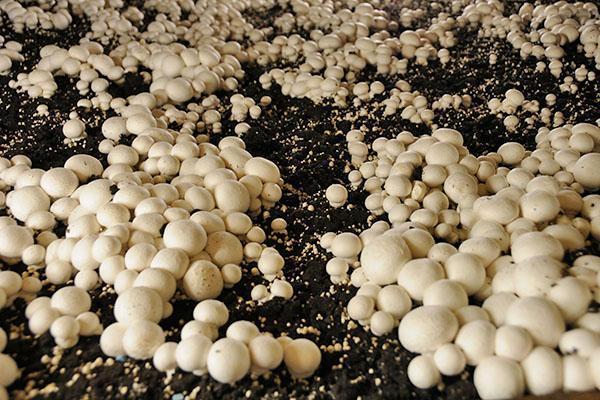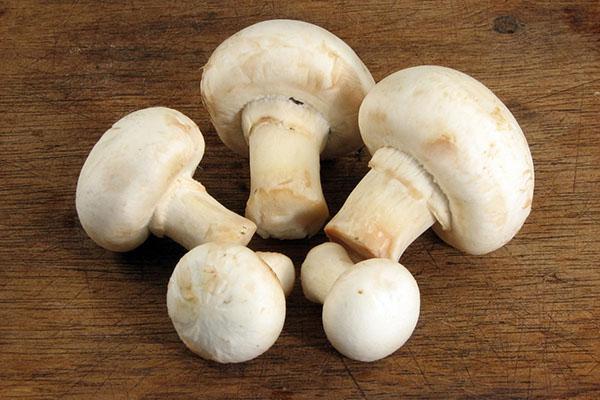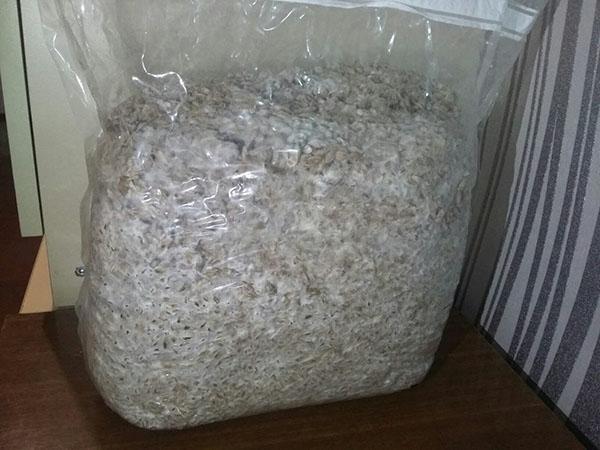Growing champignons in different ways: planting and caring for mushrooms
 In order to grow champignons in different ways to give a good harvest, you must follow some rules. Only then there will always be high-quality and delicious mushrooms in the kitchen, which will become a real boon in the preparation of various dishes.
In order to grow champignons in different ways to give a good harvest, you must follow some rules. Only then there will always be high-quality and delicious mushrooms in the kitchen, which will become a real boon in the preparation of various dishes.
The benefits of mushrooms

The main benefits of this mushroom:
- a significant amount of protein substances;
- low energy value;
- high concentration of carbohydrates;
- the presence of fatty acids;
- refers to dietary products;
- includes micro and macro elements, vitamins;
- promotes the elimination of cholesterol.
Due to its unpretentiousness and versatility, mushrooms can be grown almost anywhere: from country houses to apartments and basements of multi-storey buildings.
Mycelium selection and substrate preparation
 The success of growing any mushroom directly depends on the quality of the seed, which is why the choice of mycelium should be very responsible. You always need to pay attention to some points.
The success of growing any mushroom directly depends on the quality of the seed, which is why the choice of mycelium should be very responsible. You always need to pay attention to some points.
Mycelium types:
- Sterile mycelium is a mycelium settled on steamed grain.
- Compost mycelium - this is nothing more than a compost mass on which mushrooms were previously grown and because of this it contains mycelium
The first sign of low-quality planting material is greening, albeit small. It speaks of the presence of foreign microorganisms - molds. If a sour smell emanates from the mycelium, then it is clearly affected by bacteriosis. High-quality healthy mycelium is able to retain its properties for 2 weeks when stored in a closed package in an apartment. If you keep it in the refrigerator, then the period increases to 3 months.
To prepare a mass of compost, you need to lay out several layers. The first one is 10 kg of straw, well saturated with water. A mixture of minerals (5 kg of carbamide, 2 kg of phosphate fertilizers, 8 kg of gypsum, 5 kg of ordinary chalk) is scattered on top of it. The next layer is 100 kg of manure, which is covered again with a mixture of mineral components. The total height of such a multi-layer structure is about 1.5 meters.
Growing champignons in different ways
There are different ways of growing champignons, but not all are used by summer residents to obtain mushrooms for personal use.
Growing mushrooms in the open field
 Cultivation of mushrooms in open beds is a rather difficult task due to the specifics of champignons: they do not tolerate sunlight. Therefore, for sowing them, you will have to choose a place that is well shaded by trees, tall shrubs or choose a plot behind the house. You will also have to additionally build a protective shelter, build a canopy. It will not only provide the necessary shade, but will also protect the area from rapid drying.
Cultivation of mushrooms in open beds is a rather difficult task due to the specifics of champignons: they do not tolerate sunlight. Therefore, for sowing them, you will have to choose a place that is well shaded by trees, tall shrubs or choose a plot behind the house. You will also have to additionally build a protective shelter, build a canopy. It will not only provide the necessary shade, but will also protect the area from rapid drying.
Fungi can be contaminated with various infections through the soil, so it is necessary to insulate with plastic wrap or roofing material before placing the compost.
Before starting planting work, you should prepare the compost mixture. It can consist of straw (10-12 kg), chicken manure or regular manure (7-8 kg). The components are distributed in layers into a special pile, after which they are moistened every day, making sure that the mass does not dry out. While the compost "ripens" for 20-25 days, it will need to be loosened 5-6 times.
On the territory selected for planting, the soil is thoroughly loosened, then mycelium is evenly scattered over it, covered with a compost mixture on top with a layer of 6-8 cm, and thoroughly watered. Then they monitor the humidity of such a bed and moisten it as it dries. If everything is done correctly, then the first mushroom harvest can be obtained after about 2-2.5 months. Moreover, from 1 m2 mushroom beds can be harvested up to 12 kg of fruit bodies per month. Without transplanting on the same bed, the mycelium will bear fruit for up to 5 years in a row.
At first glance, it is unusual, but it is quite acceptable to cultivate mushrooms in the same bed together with various garden crops.
To equip such a garden, horse or cow manure is introduced into the beds 1.5 m wide, and then zucchini and squash are planted. Be sure to stretch the film over the beds. When the seedlings take root well, the mushroom mycelium is sown. These cultures get along quite well on the same territory.
Growing champignons on shelves
 This is a Dutch mushroom growing technology. The shelves are essentially the same beds, simply arranged vertically in the form of a multi-storey structure. Due to this arrangement, the production area is used as efficiently as possible. But there are several drawbacks to this method: in case of infection, the infection spreads very quickly along vertical and horizontal rows. Also, the method of growing on shelves requires special mechanisms and expensive equipment, which is more applicable for industrial growing of mushrooms. This technology is too expensive for private households.
This is a Dutch mushroom growing technology. The shelves are essentially the same beds, simply arranged vertically in the form of a multi-storey structure. Due to this arrangement, the production area is used as efficiently as possible. But there are several drawbacks to this method: in case of infection, the infection spreads very quickly along vertical and horizontal rows. Also, the method of growing on shelves requires special mechanisms and expensive equipment, which is more applicable for industrial growing of mushrooms. This technology is too expensive for private households.
Growing in containers
 This method of mushroom cultivation is also more suitable for large farms, mushroom business, rather than for cultivation only for personal purposes. This technology is practiced in Canada and the USA.
This method of mushroom cultivation is also more suitable for large farms, mushroom business, rather than for cultivation only for personal purposes. This technology is practiced in Canada and the USA.
For cultivation, containers made of wood are needed, which have undergone special treatment against mold and fungal infection. The containers are filled with a substrate and inoculated with mycelium. The different phases of fungus development take place in different rooms in which the necessary conditions are maintained. If desired and using 1-2 containers, it is quite possible to organize such a growing process at home.
Growing mushrooms in bags
 A popular and convenient cultivation method, it is suitable for small and medium-sized farms as it is not as expensive as other cultivation methods. In this case, polyethylene bags are used. For example, 25 kg each, which is filled with compost and sown with fungal spores. They are installed in such a way that it is easy to approach them. Also placed in vertical tiers. Best grown in a poultry house or vegetable store.
A popular and convenient cultivation method, it is suitable for small and medium-sized farms as it is not as expensive as other cultivation methods. In this case, polyethylene bags are used. For example, 25 kg each, which is filled with compost and sown with fungal spores. They are installed in such a way that it is easy to approach them. Also placed in vertical tiers. Best grown in a poultry house or vegetable store.
The biggest plus of this technology is that in case of infection, the focus of infection is a single bag, it is easy to eliminate.
Of the minuses, it is worth noting the complexity of self-filling containers with compost mixture, but on sale, if you wish, you can find polymer bags already filled with the substrate along with mycelium.
Block mushroom cultivation
 Many mushroom lovers now use this technology - they grow champignons from compressed substrate. Its role is played by peat, sawdust and wood, husk from seeds, manure. All this is pressed into blocks.
Many mushroom lovers now use this technology - they grow champignons from compressed substrate. Its role is played by peat, sawdust and wood, husk from seeds, manure. All this is pressed into blocks.
This method is good because:
- It does not require much space, it is even suitable for a summer cottage.
- No need for composting.
- Also, there is no need to sow mycelium, it is already in the blocks. They can be small at 2.5 kg or more impressive weight at 20 kg.
- The only thing that is needed is a special technique for loosening and applying the soil. Briquettes should be chosen carefully, since nothing can be corrected in their composition, the material must be of high quality, and not only affordable.
Pressed blocks are laid out on the shelves, several holes are made in their surface. To prevent moisture from evaporating so quickly, cover with burlap, film, paper. It is necessary to wait until the mycelium appears on the surface. After that, the blocks are sprinkled with casing layer, no longer ventilated. Moisturize only by spraying and wait about 2.5 months until fruiting bodies appear. After that it will be possible to harvest.
If you maintain optimal conditions, then from each ton you get up to 200 kg of mushrooms (20% of the return of blocks).
Potential problems with mushroom cultivation in basements
 Difficulties in mushroom production arise more often among novice mushroom growers due to non-compliance with growing conditions.
Difficulties in mushroom production arise more often among novice mushroom growers due to non-compliance with growing conditions.
Growing problems:
- A weak growth of mycelium, or its absence at all, most often occurs due to excess moisture, as well as in case of infection with springtails. To correct the situation, the substrate is inspected for contamination, moisture is reduced.
- The emergence of other types of mushrooms. There are several reasons: from poor quality mycelium to poor pre-heat treatment of compost. All extraneous fungi are removed.
- Overgrown mushroom stalk. If a “swollen” stem is formed on young champignons, it has extensions, the cap develops poorly, and the fruit bodies are irregular. All these are signs of fungal infection with verticillosis.
- Substrate spotting. When buying a low-quality substrate, its poor heat treatment, mycelium affected by mold, it begins to actively grow. At the same time, spots similar to cobwebs appear on the substrate. They can be of different colors: black, all shades of green, yellow.
You can cultivate champignons in a variety of ways. Each technology has a number of pros and cons. Therefore, before engaging in the cultivation of such mushrooms, you must choose the method that is most suitable for you personally, taking into account the conditions and capabilities, the required volumes and goals of mushroom production.